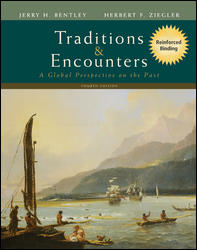Traditions and Encounters, 4th Edition (Bentley)Chapter 31:
THE AMERICAS IN THE AGE OF INDEPENDENCEOverviewIn 1800, the United States was a shaky new republic, and the rest of the Americas were controlled by European states. By 1900, the United States and Canada had claimed the entire North American continent, and most of Latin America had broken free from colonial rule. The states that emerged were vastly different from one another. Some of those differences had been apparent since the colonial era (see Chapter 25). Events of the nineteenth century further defined the societies that emerged in the Americas: - Territorial expansion. A booming population and continual immigration impelled American and Canadian settlers to press onto the western lands. Railroad construction in the late nineteenth century facilitated that expansion.
- Conflicts with indigenous peoples. Across the Americas, expansion brought settlers into lands claimed by indigenous peoples. Conflicts between Native Americans and military forces in the United States, Canada, Argentina, and Chile invariably ended badly for the natives. Survivors were usually forced onto marginal lands.
- Constitutional issues in North America. After 1800, the United States became increasingly divided, north and south, over slavery and related issues. The Civil War determined that the American "house" would no longer be "divided" and that the federal government would be more powerful than the state governments. Canada achieved independence within the framework of the British Empire, but faced challenges in creating a government that respected both British and French citizens.
- Constitutional issues in Latin America. Independence left many unresolved questions. What system would best address the inequities between creole elites and the vast majority of landless peasants? How would order be maintained? How best to advance reforms? Often, the solution seemed to be a military dictator.
- Economic development in North America. Foreign capital, a stable government, free enterprise, and abundant cheap labor: all contributed to the dramatic economic expansion of the United States in the nineteenth century. Canadian economic expansion was less spectacular but steady, especially after completion of the Canadian Pacific Railroad in 1885.
- Economic colonialism in Latin America. With a few exceptions, the economies of Latin America did not develop or diversify. Instead, Latin America continued the colonial pattern of exporting raw materials to industrial powers. While wealthy elites profited, the peasants saw their standard of living decline.
 | 
















